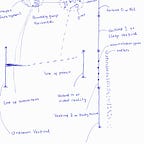Brain Science Research and Increasing Early Cancers < 50 years
The brain treats everything it processes — from internal to external senses — as what it knows or memory. All illnesses affect functions coordinated [familiar] or organized by the brain. All sicknesses are memory conditions.
The brain is the mind for everything it controls. The mind is the memory, with relaying packs across sequences.
Just like it is possible to forget, the memory can forget to give how — an organ, tissue, groups of cells, blood vessels and so on — should work, a problem in autoimmune diseases, as well as for some idiopathic conditions.
This forgetfulness could result from cycle problems like lack of sleep, others like substance abuse, lack of good nutrition and fitness and so on.
When the memory forgets, or is made to — by pathogens or others, problems from certain areas distend.
In any illness, when it is difficult to do regular things, regulated [or limited and extended] by the brain, it is still memory.
The evidence for the brain treating everything like memory is from conscious experiences.
When an individual is sick of something and there is pain elsewhere that should distress, it may not, because it is pre-prioritized or less prioritized.
Similar to having other worries, but with reduced effect except desire to heal from that condition.
The memory can also forget to give sleep or appetite in situations.
Just one store is prioritized in the memory at any moment, though interchanges with pre-prioritized are fast and numerous. All stores get prioritized at least once, across cycles.
There are symptomatic and asymptomatic conditions, where it is like knowing and not knowing — expressed by the memory.
There was a recent paper in Nature, Is early-onset cancer an emerging global epidemic? Current evidence and future implications, where they submitted that over the last few decades, cancers for people under 50 have been on the rise.
They noted that “risk factors include alcohol consumption, sleep deprivation, smoking, obesity, eating highly processed foods, sugar beverages, obesity, type-2 diabetes and sedentary lifestyle, spiking since the 1950s, possibly altering microbiome.”
A lead author of the paper said “Among the 14 cancer types on the rise that we studied, eight were related to the digestive system. The food we eat feeds the microorganisms in our gut. Diet directly affects microbiome composition and eventually these changes can influence disease risk and outcomes.”
How does the brain construct memory that lets these risk factors influence diseases?
There is the memory condition of phantom pain, where someone feels pain in a lost limb, or say the limb is lost but the memory store remains and gets visited by another, to bear that experience.
There is also the memory condition of referred pain, where pain in an area is indicative of elsewhere, like an array of stores is affected just like for side-effects of medications, where others are affected.
The memory has stores, macro and micro, as representations of everything, contiguously relaying in multiple sequences all the time — mostly in pre-prioritization, but just one as prioritized.
It is macro stores — containing similarities or commonness between micro stores — that dominate. Micro stores containing unique information transport constantly.
When there is a problem somewhere, or say an excess: sugar, sleep deprivation, lack of exercise, pathogens and so on. The large store first remembers that the extent is broken, so it moves to the principal spot and attracts familiar micro stores towards a fix.
The process results in truncation of normality of relays and sequences of pre-prioritized micro stores to other macro stores, so those functions forget then co-morbidity stems.
This is experienced in panic or fear, from an external situation affecting breathing, vasodilation and so on. It is the same with internal conditions.
For the function, if the memory can’t do anything about it, it picks the new normal and registers it as an extent [neuroplasticity].
This is possible during serious blood loss, suffocation, and so on, where it tries and tries.
In brain science, the major relay center in the brain, for all stimuli — internal and external is the thalamus, except for smell which is the olfactory bulb.
There are findings from research on other relay centers like the nucleus of the solitary tract, the reticular formation and the substantia nigra.
In these relay centers, there is processing of incoming signals. It is propounded that they are processed or integrated into a uniform identity, thought or its form, which becomes relayed for interpretation across the cortex. Interpretation is postulated to be knowing, feeling and reaction. Knowing is memory and the central of every process.
Stores and the sequence of their transport within the memory can become the problem, since their control decides the function of what they represent. The sickness can also change the memory
Just like it is possible to feel trauma because of an experience with the world, it is possible for the stomach to feel trauma because of a certain unpleasant intake. There is also depression, anxiety and so on, for internal organs, like in some aneurysms, neuropathy and so on.
Trauma is a large store in memory. It can go to the principal spot and attract micro stores linked with stomach areas, kidneys, blood vessels, nerves, kinesthesia and so on. This could also explain hangovers.
In the future, the relay of memory stores and their sequence could be a possible approach towards how to prevent diseases, even when risk factors are present.
Subscribe to DDIntel Here.
Join our network here: https://datadriveninvestor.com/collaborate
